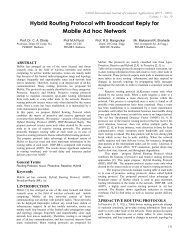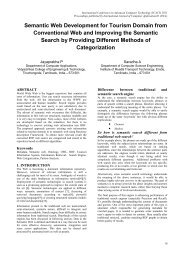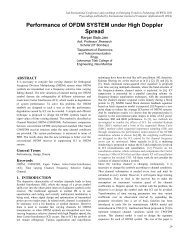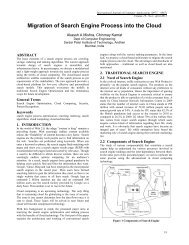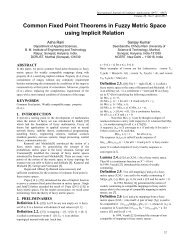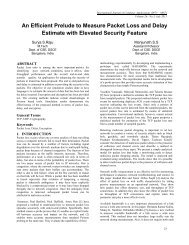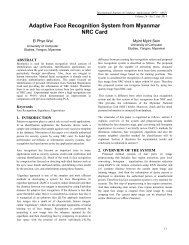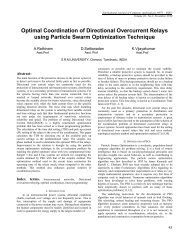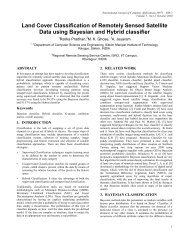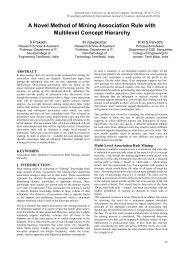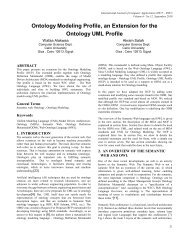IJCA Template - International Journal of Computer Applications - IJCA
IJCA Template - International Journal of Computer Applications - IJCA
IJCA Template - International Journal of Computer Applications - IJCA
Create successful ePaper yourself
Turn your PDF publications into a flip-book with our unique Google optimized e-Paper software.
<strong>International</strong> <strong>Journal</strong> <strong>of</strong> <strong>Computer</strong> <strong>Applications</strong> (0975 – 8887)<br />
Volume 7– No.7, October 2010<br />
A New Iterative Threshold Decoding Algorithm for One<br />
Step Majority Logic Decodable Block Codes<br />
M. Lahmer<br />
High School <strong>of</strong> Technologies<br />
Km5, Route gouray B.P:3103<br />
Toulal Meknes - Morroco<br />
M. Belkasmi<br />
National Institute <strong>of</strong> <strong>Computer</strong> Sciences and Systems<br />
Analysis (ENSIAS)<br />
B.P 713 – ENSIAS AGDAL<br />
RABAT-Morroco<br />
ABSTRACT<br />
The performance <strong>of</strong> iterative decoding algorithm for one-step<br />
majority logic decodable (OSMLD) codes is investigated. We<br />
introduce a new s<strong>of</strong>t-in s<strong>of</strong>t-out <strong>of</strong> APP threshold algorithm which<br />
is able to decode theses codes nearly as well as belief propagation<br />
(BP) algorithm. However the computation time <strong>of</strong> the proposed<br />
algorithm is very low. The developed algorithm can also be<br />
applied to product codes and parallel concatenated codes based on<br />
block codes. Numerical results on both AWGN and Rayleigh<br />
channels are provided. The performance <strong>of</strong> iterative decoding <strong>of</strong><br />
parallel concatenated code (17633,8595) with rate 0.5 is only 1.8<br />
dB away from the Shannon capacity limit at a BER <strong>of</strong> 10 -5 .<br />
General Terms<br />
Information theory and Coding, Signal Processing.<br />
Keywords<br />
One step majority logic decodable codes, OSMLD, iterative<br />
threshold decoding, parallel concatenated block codes,<br />
product codes.<br />
1. INTRODUCTION<br />
TURBO codes or LDPC codes are currently the most effective<br />
solution for Forward Error-Correction (FEC) in applications<br />
requiring either high code rates (R > 0.8), very low error floors, or<br />
low-complexity decoders able to operate at several hundreds <strong>of</strong><br />
megabits per second and even higher. Practical implications <strong>of</strong><br />
theses codes are numerous namely 3G wireless phones, Digital<br />
Video Broadcasting (DVB) systems, or Wireless Metropolitan<br />
Area Networks (WMAN). Turbo decoding relies on the exchange<br />
<strong>of</strong> probabilistic messages (the so-called extrinsic information)<br />
between two s<strong>of</strong>t-input s<strong>of</strong>t-output (SISO) decoders for the<br />
component convolutional codes. However, for concatenated<br />
schemes with block component codes, the computational<br />
complexity <strong>of</strong> trellis-based SISO decoding algorithms is <strong>of</strong>ten<br />
high. This has led to look for new SISO decoding algorithms with<br />
low complexity and high performance, e.g., [2]-[4]. These<br />
algorithms calculate extrinsic information using classical decoders<br />
such as Chase algorithm in [2], ordered statistics decoding<br />
algorithm in [4] and Hartmann/Rudolph algorithm in [3]. In this<br />
perspective we present a new iterative decoding algorithm based<br />
on a SISO extension form <strong>of</strong> threshold algorithm [8]. The<br />
proposed algorithm is attractive for three reasons: (1) It can be<br />
simply implemented; (2) the decoding delay is short; and (3) it has<br />
good performances. The use <strong>of</strong> the threshold algorithm in iterative<br />
decoding was introduced for the first time by Svirid [7] but for<br />
convolutional codes. Our iterative decoding process follows that<br />
given by Pyndiah in [2]. However, instead <strong>of</strong> using an extension<br />
<strong>of</strong> Chase algorithm on BCH codes, we will apply an extension <strong>of</strong><br />
Massey algorithm on one step majority logic decodable (OSMLD)<br />
codes. On the other hand Lucas et al. [3] introduce an iterative<br />
decoding algorithm for several families <strong>of</strong> codes (e.g. OSMLD<br />
codes) but they use an approximation <strong>of</strong> Hartmann/Rudolph<br />
algorithm. This paper is focused on iterative decoding <strong>of</strong> OSMLD<br />
codes.<br />
The organization <strong>of</strong> the paper is as follows. In Section 2, the basic<br />
concept <strong>of</strong> SISO Threshold decoding algorithm is introduced. In<br />
Section 3, we describe iterative decoding algorithm. Section 4 is<br />
dedicated to simulation results <strong>of</strong> BER performance for different<br />
parallel concatenated codes based on OSMLD codes.<br />
2. SOFT-IN/SOFT-OUT THRESHOLD<br />
DECODINGAGE SIZE<br />
2.1 One Step Majority Logic Codes<br />
Consider an (n, k) linear code C with parity-check matrix H.<br />
The row space <strong>of</strong> H is an (n, n-k) cyclic code, denoted by C ┴ ,<br />
which is the dual code <strong>of</strong> C, or the null space <strong>of</strong> C. For any vector<br />
v in C and any vector w in C ┴ , the inner product <strong>of</strong> v and w is<br />
zero.<br />
Now suppose that a code vector in C is transmitted over a binary<br />
symmetric channel. Let e (e 1 , e 2 , .…, e n ) and R (r 1 , r 2 , …, r n ) be<br />
the error vector and the received binary vector respectively. Then<br />
R = v + e. For any vector w in the dual code C ┴ , we can form the<br />
following linear sum <strong>of</strong> the received digits:<br />
A <br />
n<br />
<br />
p1<br />
r p w<br />
p<br />
Which is called a parity-check sum. Using the fact that =0,<br />
we obtain the following relationship between the check sum A<br />
and error digits in e:<br />
A <br />
n<br />
<br />
p1<br />
e p w<br />
p<br />
Suppose that there exist J vectors in the dual code C ┴ , which have<br />
the following properties:<br />
12
<strong>International</strong> <strong>Journal</strong> <strong>of</strong> <strong>Computer</strong> <strong>Applications</strong> (0975 – 8887)<br />
Volume 7– No.7, October 2010<br />
1. The j th component <strong>of</strong> each vector w i is a 1<br />
2. For ij there is at most one vector whose i th component is a 1<br />
These J vectors are said to be orthogonal on the j th digit position.<br />
We call them orthogonal vectors. Now, let use form J parity-check<br />
sums from these J orthogonal vectors,<br />
For each i in {1,.., J}<br />
A<br />
i <br />
p<br />
j<br />
e<br />
p<br />
e<br />
we see that the error digit e j is checked by all the check sums<br />
above. Because <strong>of</strong> the second property <strong>of</strong> the orthogonal vectors,<br />
any error digit other than e j is checked by at most one check sum.<br />
These J check sums are said to be orthogonal on the error digit e j .<br />
If all the error digits in the sum A i are zero for ij, the value <strong>of</strong> A i<br />
is equal to e j . Based on this fact, the parity-check sums orthogonal<br />
on e j can be used to estimate e j , or to decode the received digit r j .<br />
Table 1 shows some examples <strong>of</strong> OSMLD codes that can be<br />
decoded with the proposed SISO decoder described above. In this<br />
table we used the abbreviations DSC for Difference Set Cyclic<br />
codes, EG for Euclidean Geometry codes and BCH for Bose<br />
Chaudhuri and Hocquenghem codes. The EG codes used in this<br />
study are 0-order and, for an extensive description <strong>of</strong> projective<br />
geometry codes and Euclidean geometry can be found in [10].<br />
Table 1. Set <strong>of</strong> OSMLD Codes<br />
N k J d min Rate code<br />
7 3 3 4 0.42 DSC<br />
15 7 4 5 0.46 BCH<br />
21 11 5 6 0.52 DSC<br />
63 37 8 9 0.58 EG<br />
73 45 9 10 0.61 DSC<br />
255 175 16 17 0.68 EG<br />
273 191 17 18 0.69 DSC<br />
819 447 15 16 0.54 OSMLD<br />
1057 813 33 34 0.76 DSC<br />
4161 3431 65 66 0.82 DSC<br />
16513 14325 129 130 0.86 DSC<br />
2.2 Majority Logic Decoding Principle<br />
The error digit ej is decoded as 1 if at least one-half <strong>of</strong> the check<br />
sums orthogonal on ej, are equal to 1; otherwise, ej is decoded as<br />
0 like majority rule. When C is a cyclic code, each ei can be<br />
decoded simply by cyclically permuting the received word r into<br />
the buffer store.<br />
Example: let us consider the (7,3) code, which is the short code in<br />
difference set codes class (see Table 1). This code is specified by<br />
the perfect difference set P={0, 2, 3} <strong>of</strong> order 2. From this prefect<br />
set, we can form the following three check sums orthogonal on e 7 :<br />
A 1 = e 4 + e 5 + e 7<br />
A 2 = e 2 + e 6 + e 7<br />
A 3 = e 1 + e 3 + e 7<br />
The If a simple error e=(000001) occur, than we have A 1 = A 2 =<br />
A 3 = 1. If a double error occur, as an example e 7 =1 and one value<br />
j<br />
<strong>of</strong> e 1 , ..., e 6 is equal to 1, then two values <strong>of</strong> Ai are 1. So we can<br />
say that :<br />
- e 7 =1 if only and if at least 2 values <strong>of</strong> Ai are 1<br />
- e 7 =0, otherwise.<br />
2.3 S<strong>of</strong>t-input S<strong>of</strong>t-output Threshold<br />
Decoding<br />
Threshold decoding is simply the logical extension to s<strong>of</strong>t<br />
decisions <strong>of</strong> majority decoding. S<strong>of</strong>t-out decoding algorithm when<br />
applied to OSMLD codes is stated as follows:<br />
Let us consider a transmission <strong>of</strong> block coded binary symbols<br />
{0,1} using a BPSK modulation over AWGN channel, the<br />
decoder s<strong>of</strong>t output for the j th bit position <strong>of</strong> a given s<strong>of</strong>t input<br />
R(r ,r ,..,r ) is defined as:<br />
1 2 n<br />
P(c 1/ R) <br />
<br />
<br />
<br />
j<br />
LLR<br />
j<br />
ln P(c<br />
j<br />
0 / R)<br />
where C(c<br />
1,c 2,...,c n) is the transmitted codeword. The hard<br />
decision vector corresponding to the received vector r is denoted<br />
by H(h 1 , h 2, ..., h n ) .<br />
For a code with J orthogonal parity check equations, (1) can be<br />
expressed as:<br />
<br />
<br />
j<br />
i<br />
LLR<br />
j<br />
ln P(c<br />
j<br />
0 / B<br />
i<br />
<br />
<br />
P(c<br />
1/ B <br />
<br />
<br />
<br />
where B , i=1...J are obtained from the orthogonal parity check<br />
i<br />
equations on the j th bit as follows:<br />
The term B 0 is defined to be B 0 = h j . Each <strong>of</strong> the B i=1,..,J is<br />
computed by dropping the term h j from the i th orthogonal parity<br />
equation. Thus, each <strong>of</strong> the B i can be written as:<br />
n i<br />
B c e<br />
(3)<br />
i j ik<br />
k1<br />
Where<br />
eik<br />
is the k th error term in the i th parity check equation<br />
excluding e j ( n is the total number <strong>of</strong> terms in the i th orthogonal<br />
parity equation without c ).<br />
i<br />
By applying BAYES rule, (2) becomes<br />
<br />
<br />
<br />
<br />
i j j<br />
LLR<br />
j<br />
ln P( B<br />
i / c<br />
j<br />
0) P(c<br />
j<br />
0)<br />
j<br />
P( B / c 1) P(c 1)<br />
<br />
<br />
<br />
<br />
Since the parity check equations are orthogonal on the j th symbol<br />
the individual probabilities P(B / c 1 or 0) are all independent<br />
and (4) can be rewritten as<br />
J P(B<br />
i<br />
/ c<br />
j<br />
1) P(c<br />
j<br />
1)<br />
<br />
LLR<br />
j<br />
ln ln<br />
<br />
i0<br />
P(B<br />
i<br />
/ c<br />
j<br />
0) P(c<br />
j<br />
0)<br />
<br />
i<br />
Assume that the transmitted symbols are equally likely to be 0 or<br />
1, and thus the last term in (5) is null. As a result, we obtain<br />
j<br />
i<br />
(1)<br />
(2)<br />
(4)<br />
(5)<br />
13
<strong>International</strong> <strong>Journal</strong> <strong>of</strong> <strong>Computer</strong> <strong>Applications</strong> (0975 – 8887)<br />
Volume 7– No.7, October 2010<br />
J P(B<br />
i<br />
/ c<br />
j<br />
1) P(B<br />
0<br />
/ c<br />
j<br />
1)<br />
<br />
LLR<br />
j<br />
ln ln<br />
<br />
i1<br />
P(B<br />
i<br />
/ c<br />
j<br />
0) P(B<br />
0<br />
/ c<br />
j<br />
0)<br />
<br />
According to [9], (6) can be expressed as<br />
j 0 0 i i<br />
i1<br />
J<br />
LLR (1 2B )w (1 2B )w<br />
(7)<br />
where the value <strong>of</strong> ( 1 2B i<br />
) is equal to +1 or –1 and wi<br />
is a<br />
weighting term proportional to the reliability <strong>of</strong> the i th orthogonal<br />
parity check. It is easy to show that:<br />
4E<br />
(1 2B )w r<br />
and<br />
w<br />
s<br />
0 0 j<br />
N0<br />
ni<br />
<br />
1 tanh(L / 2)<br />
<br />
<br />
<br />
ik<br />
k1<br />
i<br />
ln ni<br />
<br />
1<br />
tanh(L<br />
ik<br />
/ 2) <br />
k1<br />
<br />
where ik represents the k th element <strong>of</strong> the i th parity equation and<br />
L<br />
4E<br />
s<br />
r . (10)<br />
ik<br />
ik<br />
N<br />
0<br />
Thus the s<strong>of</strong>t output can be split into two terms, namely into a<br />
normalized version <strong>of</strong> the s<strong>of</strong>t input r and an extrinsic<br />
information E representing the estimates made by the orthogonal<br />
j<br />
bits on the current bit c . Hence (7) becomes<br />
s<br />
j j j<br />
N0<br />
j<br />
4E<br />
LLR r E<br />
(11)<br />
We make the following notations:<br />
L<br />
4E<br />
s<br />
c<br />
, (12)<br />
N0<br />
which is called the reliability value <strong>of</strong> the channel.<br />
The algorithmic structure <strong>of</strong> the SISO threshold decoding can be<br />
summarized as follows:<br />
For each<br />
j 1,..,<br />
n<br />
Compute the terms<br />
B<br />
i<br />
and<br />
Calculate B and<br />
0<br />
W<br />
0<br />
Compute the extrinsic information<br />
The S<strong>of</strong>t-output is obtained by:<br />
w , i<br />
1,..,J<br />
<br />
i<br />
E<br />
j<br />
LLR<br />
j<br />
Lcrj E<br />
j<br />
2.4 Modifications for Rayleigh fading channel<br />
For our algorithm to be applicable in wireless environment, their<br />
performance on fading channels must be examined. In the channel<br />
model we use, each received bit r j can be expressed as:<br />
r a cˆ<br />
n<br />
(13)<br />
j j j j<br />
In this representation, ĉ<br />
j is a BPSK symbol associated to the<br />
transmitted bit c j , and n j is an AWGN. The Rayleigh variable a j is<br />
j<br />
(6)<br />
(8)<br />
(9)<br />
generated as<br />
a x y<br />
(14)<br />
2 2<br />
j j j<br />
where x j and y j are zero mean statistically independent Gaussian<br />
random variables each having a variance 2 . We consider the<br />
power normalized to one as<br />
2 2<br />
Ea <br />
<br />
2<br />
1<br />
j <br />
(15)<br />
which give a variance <strong>of</strong> 0.5 for Gaussien variables.<br />
On the Rayleigh fading channel, the availability <strong>of</strong> channel<br />
side information is the key issue in determining the necessary<br />
modification for the iterative threshold decoding algorithm. The<br />
threshold decoding algorithm has to be modified slightly by<br />
changing equation (12) which define the reliability value <strong>of</strong> the<br />
channel by<br />
4E<br />
L s<br />
c<br />
a<br />
(16)<br />
j<br />
N<br />
0<br />
3. ITERATIVE THRESHOLD DECODING<br />
3.1 Iterative Threshold Decoding <strong>of</strong> OSMLD<br />
codes<br />
Iterative decoding process (see Fig. 1) can be described as<br />
follows: In the first iteration, the decoder only uses the channel<br />
output as input, and generates extrinsic information for each<br />
symbol. In subsequent iterations, a combination <strong>of</strong> extrinsic<br />
information and channel output is used as input<br />
E (q)<br />
(q)<br />
The s<strong>of</strong>t input respectively the s<strong>of</strong>t output <strong>of</strong> the q th iteration is<br />
given by:<br />
R(q) R (q)E(q)<br />
(17)<br />
LLR(q) L R(q) E(q 1)<br />
(18)<br />
c<br />
E ( q 1)<br />
R (q) SISO-<br />
Threshold<br />
LLR ( q 1)<br />
Decoder<br />
R<br />
Fig. 1: The block diagram <strong>of</strong> the q th iteration.<br />
where R represent the received data, E(q) is the extrinsic<br />
information computed by the previous iteration. In our procedure<br />
we use a fixed value 1/J for the parameter (q)<br />
and this for all<br />
iterations. The value chosen for (q)<br />
reacts as an average <strong>of</strong> all J<br />
estimators which contribute in the computation <strong>of</strong> E j .<br />
3.2 Iterative Threshold Decoding <strong>of</strong> product<br />
codes<br />
The developed algorithm can also be applied to product codes and<br />
parallel concatenated codes based on block codes. Let us consider<br />
two linear block codes C 1 having parameters ( n<br />
1<br />
, k<br />
1<br />
, d<br />
1<br />
) and C 2<br />
having parameters ( n ,<br />
2<br />
k ,<br />
2<br />
d ) where<br />
2<br />
n ,<br />
i<br />
k and<br />
i<br />
d (i =1,2)<br />
i<br />
stand for codeword length, number <strong>of</strong> information bits and<br />
minimum Hamming distance respectively. It is assumed that the<br />
14
BER<br />
<strong>International</strong> <strong>Journal</strong> <strong>of</strong> <strong>Computer</strong> <strong>Applications</strong> (0975 – 8887)<br />
Volume 7– No.7, October 2010<br />
information symbols are the first k1<br />
symbols <strong>of</strong> C 1 and the first<br />
k<br />
2 symbols <strong>of</strong> C 2 1 2<br />
. The product code PC C C is an<br />
( n<br />
1<br />
n2, k1k2<br />
, d1d<br />
) code whose codeword’s are constructed by<br />
2<br />
encoding k1 k2<br />
information symbols with code C 1 and the<br />
resulting k2n1symbols with C 2 (see Fig. 2).<br />
A parallel concatenated block (PCB) code can be<br />
constructed by a parallel concatenation <strong>of</strong> block codes. The<br />
PCB code is a PC but without the checks on checks part<br />
(see Fig. 2). The rate <strong>of</strong> product code PC and PCB codes<br />
are given respectively by<br />
k1<br />
k2<br />
R<br />
PC<br />
and<br />
n n<br />
R<br />
PCB<br />
1 2<br />
k1k2<br />
<br />
.<br />
(n n ) [(n k ) (n k )<br />
1 2 1 1 2 2<br />
The major disadvantage <strong>of</strong> the parallel concatenated code is the<br />
loss in minimum distance. It is only (d1d 2)<br />
1compared to<br />
d<br />
1d2 1<br />
for the product code.<br />
The decoding procedure <strong>of</strong> product code is performed by<br />
k<br />
2<br />
k<br />
1<br />
Information symbols<br />
Checks symbols<br />
Checks<br />
symbols<br />
Checks<br />
On<br />
Checks<br />
Table 2 Set <strong>of</strong> PC and PCB codes based on OSMLD Codes<br />
Constructed code<br />
Component<br />
code (C 1 )<br />
Component<br />
code (C 2 )<br />
Rate<br />
PCB (161,49) BCH (15,7) BCH (15,7) 0.30<br />
PCB (341,121) DSC (21,11) DSC (21,11) 0.35<br />
PCB (1295,495) DSC (21,11) DSC (73,45) 0.38<br />
PCB (3293, 1369) EG(63,37) EG(63,37) 0,41<br />
PCB (4545,2025) DSC (73,45) DSC (73,45) 0.45<br />
PCB (17633,8595) DSC (73,45) DSC (273,191) 0.48<br />
PCB (67805, 36481) DSC(273,191) DSC(273,191) 0.53<br />
PC (1533,495) DSC(21,11) DSC(73,45) 0.32<br />
PC (4095,1337) BCH (15,7) DSC(273,191) 0.32<br />
PC (3969,1369) EG (63,37) EG (63,37) 0,34<br />
PC (5329,2025) DSC(73,45) DSC(73,45) 0.37<br />
PC (19929, 8595) DSC(73,45) DSC(273,191) 0.43<br />
4. SIMULATION RESULTS<br />
This section considers simulation results and analysis for some<br />
OSMLD codes, product codes and parallel concatenated blocks<br />
codes. We would like to notify that for all our simulations we<br />
have used a minimal residual error bit <strong>of</strong> 200 and residual error<br />
block <strong>of</strong> 30. We have used a number <strong>of</strong> iterations such that there<br />
is no significantly more gain by more iteration. The performance<br />
improves with each iteration in all simulation results presented.<br />
4.1 Performances <strong>of</strong> OSMLD codes<br />
Figure 3 depicts the performance <strong>of</strong> iterative decoding <strong>of</strong> (1057,<br />
813) DSC code with rate 0.76. We can see that the performance<br />
improves with each iteration. The first iteration show the<br />
performances <strong>of</strong> classical threshold decoding [8].<br />
n 2<br />
n 1<br />
1 1.5 2 2.5 3 3.5 4 4.5 5<br />
10 -1 SNR (dB)<br />
Fig. 2 : Construction <strong>of</strong> a Product code<br />
cascading elementary decoders (rows and columns). On receiving<br />
matrix [R], the first decoder performs the s<strong>of</strong>t decoding <strong>of</strong> the<br />
rows (or columns) using as input matrix [R]. S<strong>of</strong>t Input / S<strong>of</strong>t<br />
Output decoding is performed using the new proposed algorithm.<br />
Tables 2 show some examples <strong>of</strong> constructed product and PCB<br />
codes by using codes in table 1.<br />
10 -2<br />
10 -3<br />
10 -4<br />
10 -5<br />
10 -6<br />
iter (1)<br />
iter (2)<br />
iter (4)<br />
iter (8)<br />
iter (15)<br />
Fig.3 : BER performance <strong>of</strong> (1057, 813) code on AWGN<br />
channel<br />
Figure 4 shows the frame error rate (FER) performance <strong>of</strong> (73,45),<br />
(273,191), (819,447) and (1057,813) codes on both AWGN and<br />
Rayleigh fading channel. As it can be seen the slope <strong>of</strong> the<br />
frame-error rate (FER) curve is as steep as for the Gaussian<br />
15
BER<br />
FER<br />
BER<br />
<strong>International</strong> <strong>Journal</strong> <strong>of</strong> <strong>Computer</strong> <strong>Applications</strong> (0975 – 8887)<br />
Volume 7– No.7, October 2010<br />
channel. It is worth mentioning that the number <strong>of</strong> iterations<br />
needed for Rayleigh fading channel is about the same as for the<br />
AWGN channel.<br />
10 -1<br />
10 0 SNR (dB)<br />
10 -2<br />
10 0<br />
10 -1<br />
10 -3<br />
10 -5 (1057,813)-15iter<br />
0 1 2 3 4 5 6 7 8 9 10<br />
SNR (dB)<br />
4.2 Normal Gauss or Body Text<br />
Rayleigh<br />
Please use a 9-point Times Roman font, or other Roman font with<br />
10<br />
serifs, -2<br />
as close as possible in appearance to Times Roman in<br />
which these guidelines have been set. The goal is to have a 9-<br />
point text, as you see here. Please use sans-serif or nonproportional<br />
fonts only for special purposes, such as<br />
distinguishing source code text. If Times Roman is not available,<br />
try the 10 -4<br />
font named <strong>Computer</strong> Modern Roman. On a Macintosh,<br />
(73,45)-5iter<br />
use the font (273,191)-8iter named Times. Right margins should be justified, not<br />
(819,447)-15iter<br />
ragged.<br />
Fig. 4: FER performance <strong>of</strong> (73,45), (273, 191), (819, 447) and<br />
(1057,813) codes on AWGN and Rayleigh fading channels<br />
OSMLD codes are LDPC(Low Density Parity Check) codes and<br />
can be decoded by belief propagation (BP) algorithm [11]. BER<br />
Performance <strong>of</strong> iterative decoding for (73,45) and (273,191)<br />
codes are shown and compared to those <strong>of</strong> BP[11] in Figure 5. As<br />
it can be seen our results are worse by 0.2 dB at BER 10 -5 . This<br />
coding gain is negligible compared to the required complexity<br />
(see Table 3).<br />
Table 3 shows simulation time to decode 1000 frame <strong>of</strong> (73, 45),<br />
(273,191), (819,447) and (1057, 813) codes with our algorithm<br />
and BP algorithm using 15 iterations (by using a computer with<br />
Pentium 4, 3.06 GHz ). We can observe that as the code length<br />
increases the computational time complexity <strong>of</strong> BP increases<br />
compared to that <strong>of</strong> our iterative decoding algorithm.<br />
4.3 Performances <strong>of</strong> product codes<br />
This section considers simulation results and analysis for some PC<br />
and PCB codes, all <strong>of</strong> which use one step majority logic<br />
decodable (OSMLD) component codes (see Table 2).<br />
In Fig.6, we present the simulation results for the (4545, 2025)<br />
PCB code <strong>of</strong> rate 0.45 constructed from (73, 45) DSC code. We<br />
can see that the improvement is great for the first iterations and is<br />
negligible after the 16 th iteration. Here we recognize the Turbo<br />
effect.<br />
In Fig.7, we present a comparison between our simulation results<br />
and results published in [3] for the (4545, 2025) PCB code.<br />
Although they use a modified Gaussian channel with a tanh<br />
function modulation, their results are worse by 0.6 dB at a BER <strong>of</strong><br />
10 -4 .<br />
The Fig. 8 shows that performance results after 50 iterations for<br />
the (17633,8595) PCB code is only 1.8 dB away from the<br />
Shannon capacity limit at a BER <strong>of</strong> 10 -5 .<br />
In Fig.9, we present the simulation results for the (1533,495)<br />
asymmetric PC code <strong>of</strong> rate 0.32 constructed from (21, 11) and<br />
(73, 45) DSC code. As can be seen, performance increases with<br />
each iteration.<br />
10 -3<br />
10 -4<br />
10 -5<br />
10 -6<br />
10 -7<br />
(73,45)-5iter<br />
(73,45)-BP,50iter<br />
(273,191)-8iter<br />
(273,191)-BP,50iter<br />
0 0.5 1 1.5 2 2.5 3 3.5 4 4.5 5<br />
Fig. 5: Performance <strong>of</strong> (73,45) and (273,191) in comparison<br />
with BP on AWGN channel<br />
Table 3 : Comparison in terms <strong>of</strong> time computation and error<br />
performances<br />
Codes Our<br />
algorithm<br />
BP<br />
algorithm<br />
Gain <strong>of</strong> BP<br />
at BER=10 -5<br />
(73,45) 4[s] 23[s] 0.2 dB<br />
(273,191) 58[s] 300[s] 0.2 dB<br />
(1057,813) 801[s] 13000[s] 0.45 dB<br />
10 0<br />
10 -1<br />
10 -2<br />
10 -3<br />
10 -4<br />
iteration (1)<br />
iteration (2)<br />
10 -5 iteration (4)<br />
iteration (8)<br />
iteration (16)<br />
10 -6 iteration (20)<br />
1 1.5 2 2.5<br />
SNR (dB)<br />
Fig. 6 Performance <strong>of</strong> iterative decoding <strong>of</strong> the (4545,2025)<br />
code on AWGN channel<br />
The curves in Fig.10 present the simulation results for the<br />
(1253,495), (4545,2025) PCB codes and (5329,2025) PC. The<br />
PC is compared to two PCB codes. In the first case, the PC is<br />
compared to the PCB code constructed from the same component<br />
codes ((73, 45) DSC code). As envisaged, the PC outperforms the<br />
PCB code. In the second case, the PC is compared to a PCB code<br />
with same rate. As can be seen, the PC is better than PCB code. It<br />
seems that contrary to the PCB codes, product codes doesn’t have<br />
error floor. Furthermore, product codes are better than PCB codes<br />
for larger SNR.<br />
16
BER<br />
BER<br />
BER<br />
BER<br />
<strong>International</strong> <strong>Journal</strong> <strong>of</strong> <strong>Computer</strong> <strong>Applications</strong> (0975 – 8887)<br />
Volume 7– No.7, October 2010<br />
In Fig.11, we present a comparison between our simulation results<br />
for (1533, 495) product code and results published in [12] for<br />
convolutional turbo code <strong>of</strong> rate 1/3 using 16 states. We can<br />
observe that product code have worse performance at low SNR<br />
compared to convolutional code, whereas at SNR> 4.3 dB, the<br />
product code are better.<br />
10 -1<br />
10 -2<br />
10 0 SNR<br />
10 -1 SNR (dB)<br />
(4545,2025) Lucas<br />
(4545,2025) 20iter<br />
10 -3<br />
10 -2<br />
10 -3<br />
10 -4<br />
10 -5<br />
iteration-1<br />
iteration-2<br />
iteration-4<br />
iteration-8<br />
iteration-16<br />
iteration-32<br />
0 0.2 0.4 0.6 0.8 1 1.2 1.4 1.6 1.8 2<br />
10 -4<br />
10 -5<br />
Fig. 9 : Performance <strong>of</strong> iterative decoding <strong>of</strong> the (1533, 495)<br />
product code on AWGN channel<br />
10 0 SNR<br />
10 -6<br />
1 1.5 2 2.5<br />
Fig. 7 : Performance <strong>of</strong> iterative decoding <strong>of</strong> the PCB(4545,<br />
2025). The BER <strong>of</strong> the Lucas et al.[3] algorithm is given as<br />
reference.<br />
10 -1<br />
10 -2<br />
10 -3<br />
10 0 SNR (dB)<br />
PCB(17633,8595) R=0.48<br />
Shannon Capatity Limit R=0.48<br />
10 -4<br />
10 -1<br />
10 -2<br />
10 -5<br />
(1253, 495)-iter-8<br />
(4545, 2025)-iter-8<br />
(5329, 2025)-iter-8<br />
10 -6<br />
1 1.2 1.4 1.6 1.8 2 2.2 2.4 2.6 2.8 3<br />
10 -3<br />
10 -4<br />
Fig. 10 : Performance <strong>of</strong> iterative decoding <strong>of</strong> the<br />
PC(5329,2025),PCB(4545,2025) and PCB(1253,495) codes<br />
10 -5<br />
10 -6<br />
0 0.2 0.4 0.6 0.8 1 1.2 1.4 1.6 1.8 2<br />
Fig. 8 : Performance <strong>of</strong> the (17633,8595) PCB code compared<br />
to Shannon capacity limit<br />
Fig. 11: Performance <strong>of</strong> iterative decoding <strong>of</strong> the (1533, 495)<br />
product code on Rayleigh fading channel<br />
17
<strong>International</strong> <strong>Journal</strong> <strong>of</strong> <strong>Computer</strong> <strong>Applications</strong> (0975 – 8887)<br />
Volume 7– No.7, October 2010<br />
5. CONCLUSION<br />
In this paper we have presented a new iterative threshold<br />
decoding algorithm for simple codes, product codes and parallel<br />
concatenated block codes based on one-step majority logic<br />
decodable codes. We use an extension <strong>of</strong> Massey’s algorithm [8]<br />
as a S<strong>of</strong>t input/ S<strong>of</strong>t-output component decoder. The structure <strong>of</strong><br />
our iterative decoder follows the model <strong>of</strong> Pyndiah [2] with some<br />
modifications. This algorithm has been tested on several codes<br />
based on OSMLD codes and good performances have been<br />
obtained over the Gaussian and Rayleigh fading channels. It is<br />
interesting to extend this iterative decoding algorithm on quasicyclic<br />
and multi-step majority logic decodable codes.<br />
6. REFERENCES<br />
[1] C. Berrou, A. Glavieux and P. Thitimajshima, “Near<br />
Shannon limit error-correcting coding and decoding : Turbocodes<br />
(1),” IEEE Int. Conf. on Comm. ICC’93, Geneva, May<br />
1993, pp. 1064-1071.<br />
[2] R. Pyndiah, “Near-Optimum Decoding <strong>of</strong> Product Codes:<br />
Block Turbo Codes,” IEEE Trans. Commun., Aug. 1998,<br />
Vol. 46, N° 8, pp. 1003-1010.<br />
[3] R. Lucas, M. Bossert and M. Breitbach, “On Iterative S<strong>of</strong>t-<br />
Decision Decoding <strong>of</strong> Linear Binary Block Codes and<br />
Product Codes, “ IEEE <strong>Journal</strong> on selected areas in<br />
communications, February 1998, Vol.<br />
[4] M. P. C. Fossorier and S. Lin. “S<strong>of</strong>t-Input S<strong>of</strong>t-Output<br />
Decoding <strong>of</strong> Linear Block Codes Based on Ordered<br />
Statistics,” Proc. 1998 IEEE Global Telecomm. Conf.<br />
(GLOBECOM’98), Sydney, Australia Nov. 1998. pp. 2828-<br />
2833,<br />
[5] J. Hagenauer, E. Offer, and L. Papke, “iterative decoding <strong>of</strong><br />
binary block and convolutional codes,” IEEE Trans. Inform.<br />
Theory, Mar. 1996, Vol. 42, pp. 429-446.<br />
[6] R. Lucas, M. P. C. Fossorier, Yu Kou, and Shu Lin,<br />
“Iterative Decoding <strong>of</strong> One-Step Majority Logic Decodable<br />
Codes Based on Belief Propagation,“ IEEE Trans. Commun,<br />
June 2000, VOL. 48, NO. 6, pp.931-937.<br />
[7] Yuri V. Svirid and Sven Riedel, “Threshold Decoding <strong>of</strong><br />
Turbo-Codes,” IEEE Int. Symposium on Information<br />
Theory, 1995, pp. 39.<br />
[8] J.L Massey, “Threshold Decoding,” Cambridge, Ma, M.I.T.<br />
Press, 1963.<br />
[9] C. Clark and B. Cain, “Error-Correction Coding for digital<br />
communications,” Plenum Press, 1981.<br />
[10] S. Lin and D. J. Costello, “Error Control Coding,<br />
Fundamentals and <strong>Applications</strong>,” Englewood Cliffs, NJ:<br />
Prentice-Hall, 1983.<br />
[11] R. Lucas, M. P. C. Fossorier, Yu Kou, and Shu Lin,<br />
“Iterative Decoding <strong>of</strong> One-Step Majority Logic Decodable<br />
Codes Based on Belief Propagation,“ IEEE Trans. Commun,<br />
June 2000, VOL. 48, NO. 6, pp.931-937<br />
[12] S. A. Barbulescu, “Iterative decoding <strong>of</strong> turbo codes and<br />
other concatenated codes,” thesis, University <strong>of</strong> South<br />
Australia, Februry 1996, pp 869-870.<br />
18



